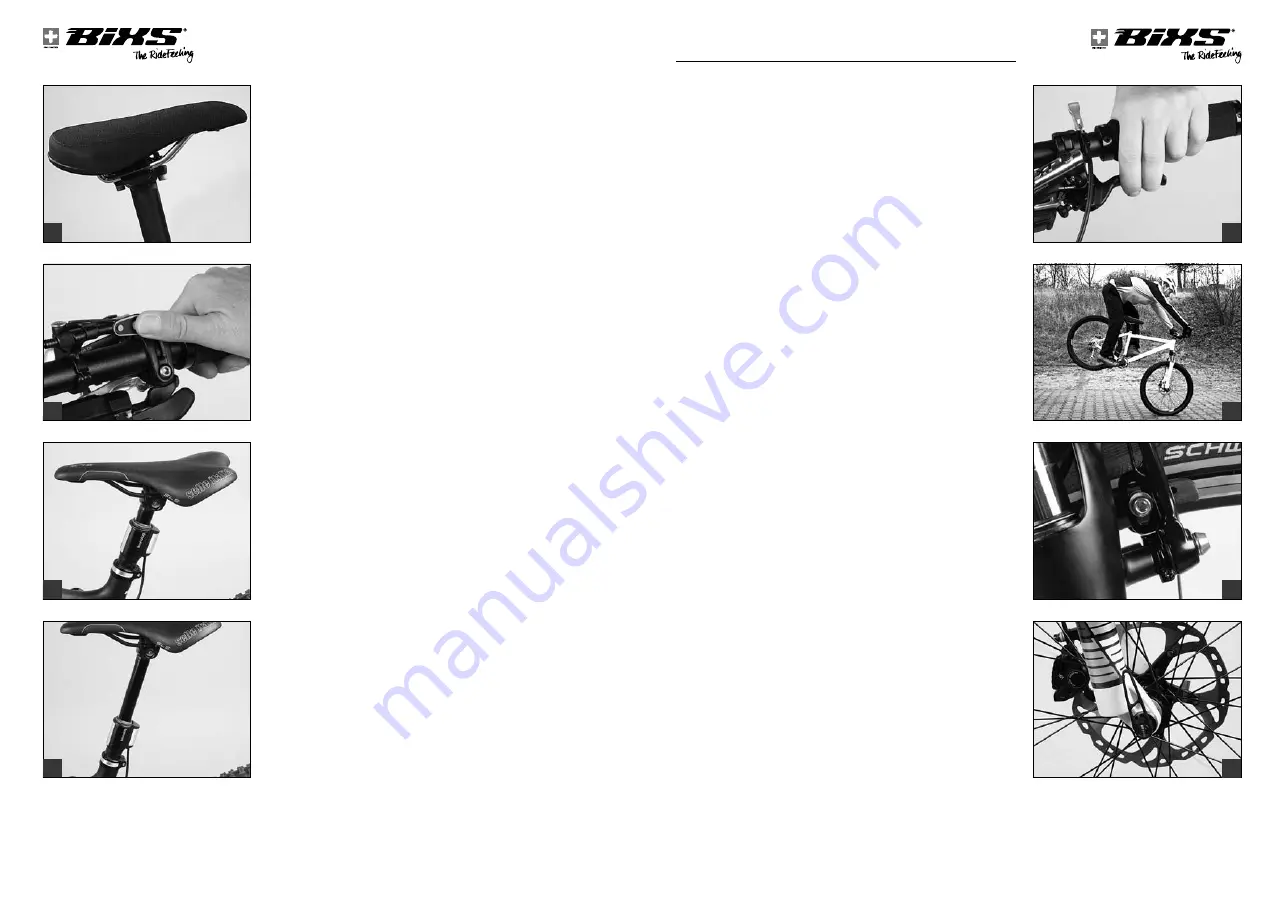
50
51
a
Not all BiXS mountain bikes that look like a dirt, freeride
or downhill bike are actually sports equipment! If you are
in doubt or if you have any questions, contact your bicycle
dealer.
Adjusting the saddle to the correct height
BiXS Dirt, freeride, dual slalom and downhill bicycles etc. require dif-
ferent saddle adjustments, according to the specific use. The seating
position cannot be capared to that on other bicycles; it is maximum
control and movability that counts when riding one of the aforemen-
tioned bicycles.
When you set off for a long cycling tour, the saddle should be set to a
height which gives maximum pedalling comfort and efficiency. When
pedalling, the ball of your big toe should be positioned above the centre
of the pedal spindle. With your feet in this position you should not be
able to stretch your legs completely straight at the lowest point, other-
wise your pedalling will become awkward.
You can check the height of your saddle in the following, simple way.
This is best done wearing flat-soled shoes. Sit on the saddle and put
one of your heels on the pedal at its lowest point. In this position your
leg should be fully stretched and your hips should remain horizontal.
For
freeriding, downhill racing etc. the saddle is set to a very low height
with a rearward tilt
(a)
. Ask your trainer, a competent person in your
club or contact your BiXS bicycle dealer for further information.
For detailed instructions on how to adjust the saddle, read chapter
“ad-
justing the bixS bicycle to the rider”
.
G
After only one season these types of BiXS bicycle may
be so worn that essential and/or supporting parts will al-
ready need replacing. Have bicycles of this type thoroughly
checked at least every 3 to 4 months.
A
A lower saddle is advisable in particular for steep downhill
riding by BiXS bicycle. Prolonged riding with a low saddle
may cause knee trouble.
I
In the case of height adjustable seat posts
(b-d)
, such as
the Reverb from RockShox, the height is adjusted by press-
ing a button on the handlebars. Read the operating instruc-
tions, which you can find on the enclosed CD.
brake SyStem
GENERAL INFoRMATIoN oN BRAKES
Brakes
(e)
are used to adjust your speed to the surrounding terrain
and traffic. In an emergency situation, the brakes must bring the BiXS
bicycle to a halt as quickly as possible.
In the process of such emergency braking, the rider’s weight shifts
abruptly forward, thus reducing the load on the rear wheel. The rate of
deceleration is primarily limited by the danger of the rear wheel losing
contact with the ground, resulting in an overturning of the BiXS bicycle
and, secondly, by the grip of the tyres on the road
(f)
. This problem
becomes particularly acute when riding downhill. Therefore, in case of
an emergency braking situation you must try to put your weight back
and down as far as possible.
Actuate both brakes simultaneously and bear in mind that, due to the
weight transfer, the front brakes can generate a far better braking effect
on a surface with good grip.
The braking conditions on unpaved surfaces differ, i.e. overbraking the
front wheel can make the wheel skid. Therefore, be sure to practise
braking on different kinds of surface. Wet weather reduces the brak-
ing power. Actuate the brakes carefully when riding on wet or slip-
pery ground, as the tyres can easily skid. Therefore, reduce your speed
when riding in such conditions.
I
Read the brake manufacturer’s operating instructions,
which you can find on the enclosed CD. After every adjust-
ment, check the brake in a place free of traffic to get a
feeling for it.
There are various types of brake systems that may be subject to the
following problems:
rim brakes
(g)
are liable to overheating as a result of too long braking
or brake dragging. This can damage the inner tube or make the tyre slip
on the rim, causing a sudden loss of air which could lead to a serious
accident in the process.
With
roller, drum, back-pedal
and
disc brakes
(h)
prolonged braking
or permanent dragging of brake pads can also lead to an overheating of
the brake system. This can result in a reduction of the braking power or
even brake failure.
risk of accidents!
a
b
c
d
e
f
g
h
Summary of Contents for Chamois
Page 69: ......
















































